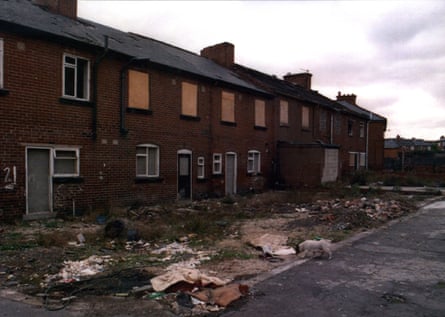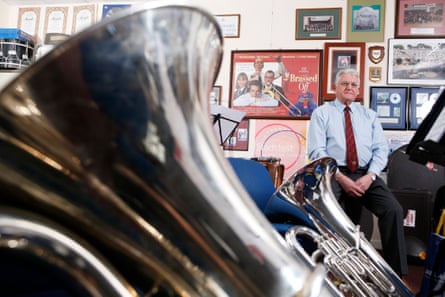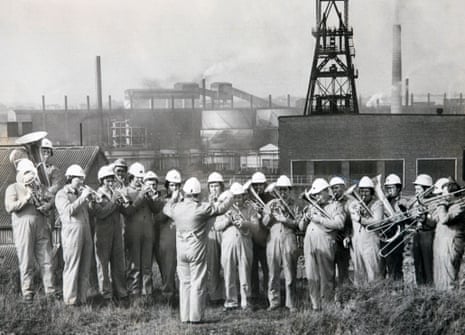At the end of a year without wages, their families impoverished and embittered by the struggle they had lost, thousands of Grimethorpe miners gathered in the centre of the village behind the colliery brass band to march back to work.
It was 5 March 1985, two days after a defeated Arthur Scargill voted to end the country’s longest-running industrial dispute without a peace deal.
Thirty years on, many residents of the small South Yorkshire village cannot recall that day without shedding tears over what they had lost.
Beryl Sargesson, 67, a warden at St Luke’s church, watched her husband, Harry, with her heart full of “pride and tears”. Almost a century earlier, in 1893, Harry’s grandfather had helped sink the mine, living in a wooden hut on what was then a tiny hamlet amid green fields, before raising a family to bring coal from the pit he built.
In Libbi’s cafe in the Acorn centre, home to the local library, Sargesson dabbed at her eyes with a handkerchief, chiding herself for her emotion that still bubbles to the surface 30 years later. She said: “I watched from the end of the road. I watched and I cried.”
Times were changing – and everyone who marched that day knew it. The strike had failed to halt Margaret Thatcher’s plan to shut 20 mines, with the loss of 20,000 jobs. More were to follow.
Sargesson’s husband was the last of the family to work in the Grimethorpe pit. Less than a decade later, the economic and political landscape had altered irrevocably and Britain’s mining industry was all but gone. The last coal was cut at Grimethorpe colliery in 1992. The pit – for almost a century the lifeblood of the community – was demolished in 1994.
Danny Gillespie, 71, a self-confessed “pit nut” who has “crawled further on my hands and knees than I’ve walked in my life”, said the march back to work marked the end of an era, even though the pit would stay open a further nine years.
“The whole atmosphere had totally changed,” said Gillespie, whose son, Steven, followed him down the mine, while his wife, Kathleen, worked at the power station. “We were degraded. We felt broken.
“We believed in our own hearts the strike was the right thing to do. But we’d lost and that feeling …” He stopped for a moment, letting out a long, heavy sigh. “That lasted for a long long time. From a happy atmosphere, to being downtrodden. It was terrible.”
When the pit finally closed, “Barnsley council thought everyone would leave,” he said.
But against all odds, thanks to a community forged amid the harsh and dangerous conditions underground, Grimethorpe has turned its fortunes around.

Things got worse before they got better. Those young enough and with transferable skills moved elsewhere, leaving abandoned houses. Streets that had been full of life long into the small hours, with men coming and going amid changes of shift, were silent and dark. The sport facilities once maintained by the coal board fell into disrepair. Unemployment during the 1990s stood at 50%. At one point, crime shot up from 30% below the national average to 20% above. Housing estates were over-run with drugs.
In 1994, a European Union study on deprivation listed Grimethorpe as the poorest village in the country.
Gillespie recalled: “When the mines closed all the toe rags and thieves that used to pinch stuff from the pit started pinching stuff from the people who lived around here. Selling drugs, growing cannabis, stealing cars.”
Such crimes went unreported because, after the violent clashes with police during the strike, the miners and their families refused to talk to them.
A bear of a man whose extended family includes seven great-grandchildren, Gillespie was the first to admit that, for two years after the pit closed, he “seized up. I was in shock. We all were.”
But when Gillespie, a miner for 36 years – whose face is well known in the village – witnessed crimes committed in front of him, he decided it was time to fight back.
“Druggies started walking around thinking they were 10 tonnes,” he said. “We wanted to stand up and be counted. Do we want criminals or do we want to work with police?”
He and another resident, Elsie Smith, began a Neighbourhood Watch scheme and worked hard at convincing the community to report crimes. Others, including Sargesson, were active in lobbying for new roads and public transport, to help local employment.
“We got things going for the youth, for disadvantaged kids that nobody cared about. These were kids bred to go down the mine – well, that was what the government thought,” she said.
By 2000, burglaries were down 23% and car crime by 43%, and the Neighbourhood Watch scheme was named the best in the country.
As the community rolled up its sleeves, so too did local and national government.
More than £100m was spent in the village from 1996-2008, according to councillor Steve Houghton, the former head of the multi-agency Grimethorpe Regeneration Board, who was knighted in 2013. It enabled 100,000 tonnes of contaminated and toxic waste to be cleared from spoil heaps, the new link road to be built and the industrial estate to be developed.
“It was the biggest single investment in any one community, from public private and European money,” said Houghton. It brought in 50 new businesses, including the UK’s distribution centre for online fashion retailer Asos, and 4,500 jobs, he said.
“It is incredible that the people of Grimethorpe have stuck it out and worked their way through it. It is a good place to do business.”
Barnsley council built 500 new homes, bringing newcomers, some with more money to spend. Libbi’s, a vintage cafe with 1950s crockery and home-baking, opened six months ago. The high street, with its post office and takeaways, now has a flower and gift shop, Helen’s Blooms.
Not everyone is happy. There are pockets of unemployment, especially among the young. Barnsley has 8.6% unemployment compared with 6.5% across the UK, and it has more than double the number of people aged 18-24 on jobseeker’s allowance than the country as a whole. Some say there are not enough local people and too many new European migrants employed here.
Houghton said that Asos recruited 80% of its workforce from a 20-mile radius.
“We put in training schemes for local people,” he said. “But we have to abide by the laws of the labour market, you can’t guarantee local people are employed over European labour.”
One of the reasons for a stubborn minority of unemployment in the village is “third-generation worklessness”, he said. “We are chipping away at that.”
“Some people find it very hard to deal with the discipline of work. That’s the legacy of the pit closures. There were social consequences of a skilled workforce leaving.”
The village has “changed hugely”, according to Houghton. “That’s not to say we’ve cracked everything. We’re proud of our history in Barnsley, but we can’t be a prisoner of it.”
Today, a trip around the sprawling village, built across a low valley, reveals no trace of the massive infrastructure that once provided a livelihood for 6,000 men, save the names of surrounding roads leading from Barnsley, such as Engine Lane and Colliery Road.

Barnsley-born Peter Haigh, 70, an administrator for the National Coal Board at the colliery from 1978-94, points out the industrial estate where the yard used to be and the sites of the old social clubs and pubs. Three out of six – Red Rum, the Bullet and Grimethorpe working men’s club – are still going.
Haigh said the closures “sickened us all, including management”. In the village, the mine was everything, with the coal board providing funding for the bowling green, the football and cricket fields, annual galas and social events.
Looking back on the day he heard the mine was to close, he recalled: “I said: ‘What do we do, where do I go?’ It was my life. We might have been in management but we were all of the same mind. Not just the men, but everybody was going to be affected. We were in the mining industry we didn’t let it show. But we all loved the industry.”
He was “one of the lucky ones”, he said, with a good pension. Now Haigh, who lives in neighbouring Cudworth, volunteers as an administrator for the world-renowned Grimethorpe Colliery Band, featured in the film Brassed Off. Among the 30-strong band, which began in 1917, there is only one former colliery worker.
But in the band’s rehearsal space, in the Acorn centre, where the coal board’s offices once stood, all chairs point towards a framed photograph of the long-gone Grimethorpe pit. “To make sure we don’t forget where we started,” said Haigh.
At St Luke’s church, two memorials stand side by side, a reminder of the harsh realities of colliery life. More men from the village lost their lives in Grimethorpe Colliery than died during two world wars.
While there are some who find it hard to move on, Gillespie and Smith are not among them.
“A lot of lives have been saved since the pit closed,” said Gillespie. “I left school at 14. I was going to be a farmer. But at 15 my mam took me to the pit and on my 16th birthday I went straight down the mine. You learned a sixth sense, when a wall’s going to fall.”
Smith, who laughed as she recalled having to clean the washing line before hanging up wet clothes, said: “Oh, it was so dirty. The soot. The village is a lot better now.”
Her granddaughter has 19 GCSEs, she said. “You’d have never got that in the old days.”
Gillespie said: “People used to say to me, “I wouldn’t live in Grimethorpe for a gold pin. But you wouldn’t believe how many new people live here – bankers and firemen, all kinds. We call this God’s country. The countryside’s beautiful round here.”
